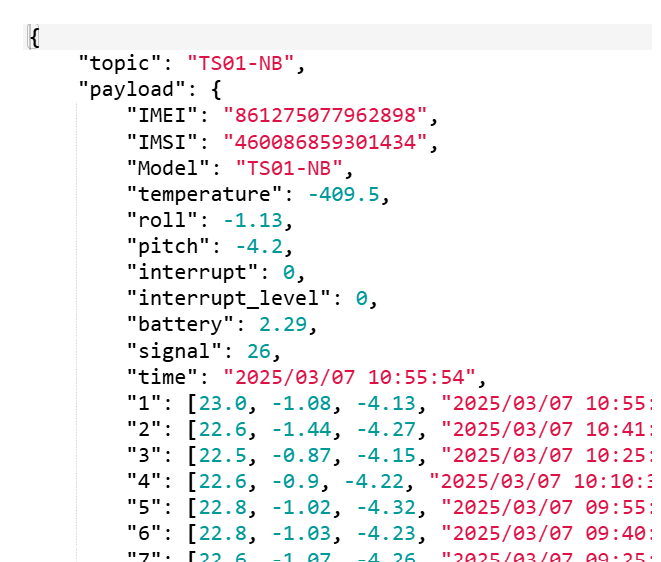Table of Contents:
- 1. Introduction
- 2. Prerequisites
- 3. Data Converters
- 4. Add Integration
- 5. Verifying the receipt of data from virtual devices
- 6. Creating a Dashboard
- 7. Configure NB-IoT Sensor
1. Introduction
This document guides you on integrating Dragino -NB and -CB series devices data with ThingsBoard. For this guide, we use ThingsBoard Cloud, which is one of the ThingsBoard versions that allows you to try it for free.
The NB series devices end with the suffix -NB, and the CB series devices end with the suffix -CB. For example, S31B-NB is an NB device, and S31-CB is a CB device.
2. Prerequisites
To complete this tutorial, you need to have the following:
- ThingsBoard cloud account
- MQTT Broker (public or private) such as,
- HiveMQ Cloud - You can create a free account to try it or subscribe for a paid account. - We use HiveMQ Cloud as the MQTT broker to build example in this tutorial.
- emqx - The public MQTT server is only used for MOTT learning and testing, and should not be used in the production environment.
- lns1.thingseye.io - This is Dragino's MQTT broker, which requires a CA certificate to use.
2.1 ThingsBoard Cloud
Go to https://thingsboard.io/
Click on the Try it now.
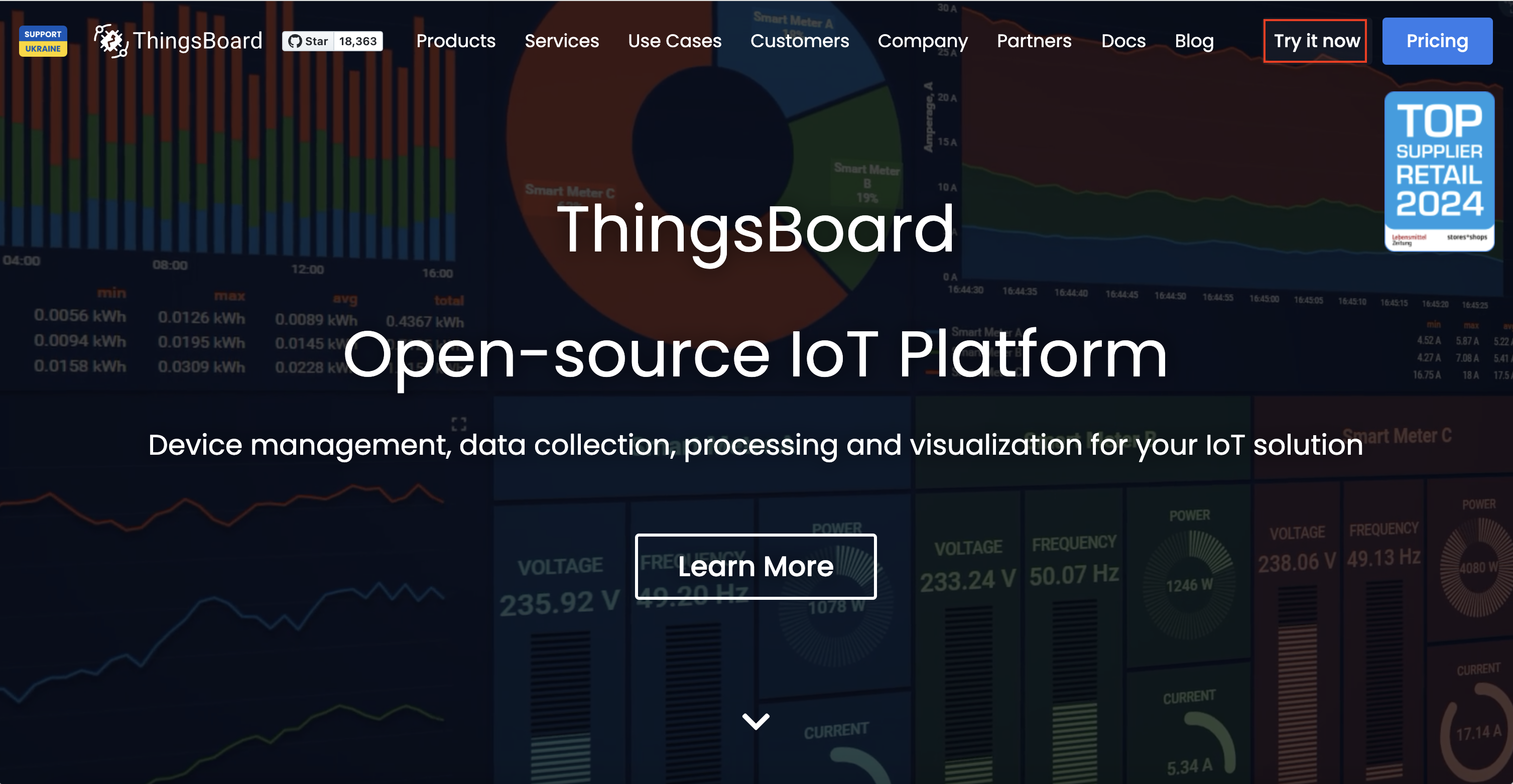
Select either the North America or Europe region. Here, we use the Europe region.
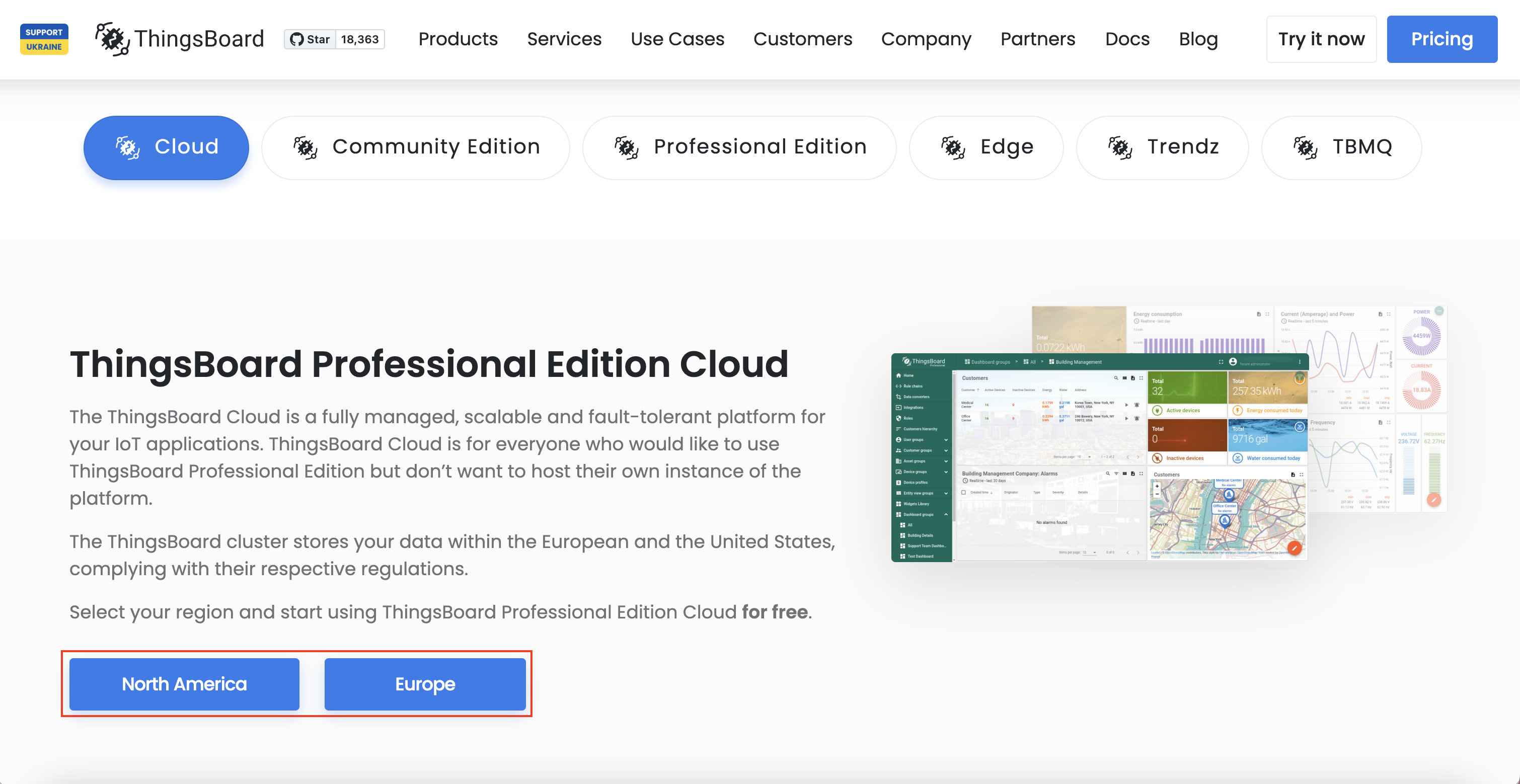
You can sign up with your Google, GitHub, Facebook, or Apple account. If not you can create an account with providing your name, email address and a password.
Click on the Sign up button.

You will be navigated to the following page.

simultaneously, you will receive an email to confirm your email address. Click on the Activate Your Account button.

Now losing to the account using your credentials:

2.2 HiveMQ Cloud
2.2.1 HiveMQ Cloud
Go to https://www.hivemq.com
Click on the Start Free button.
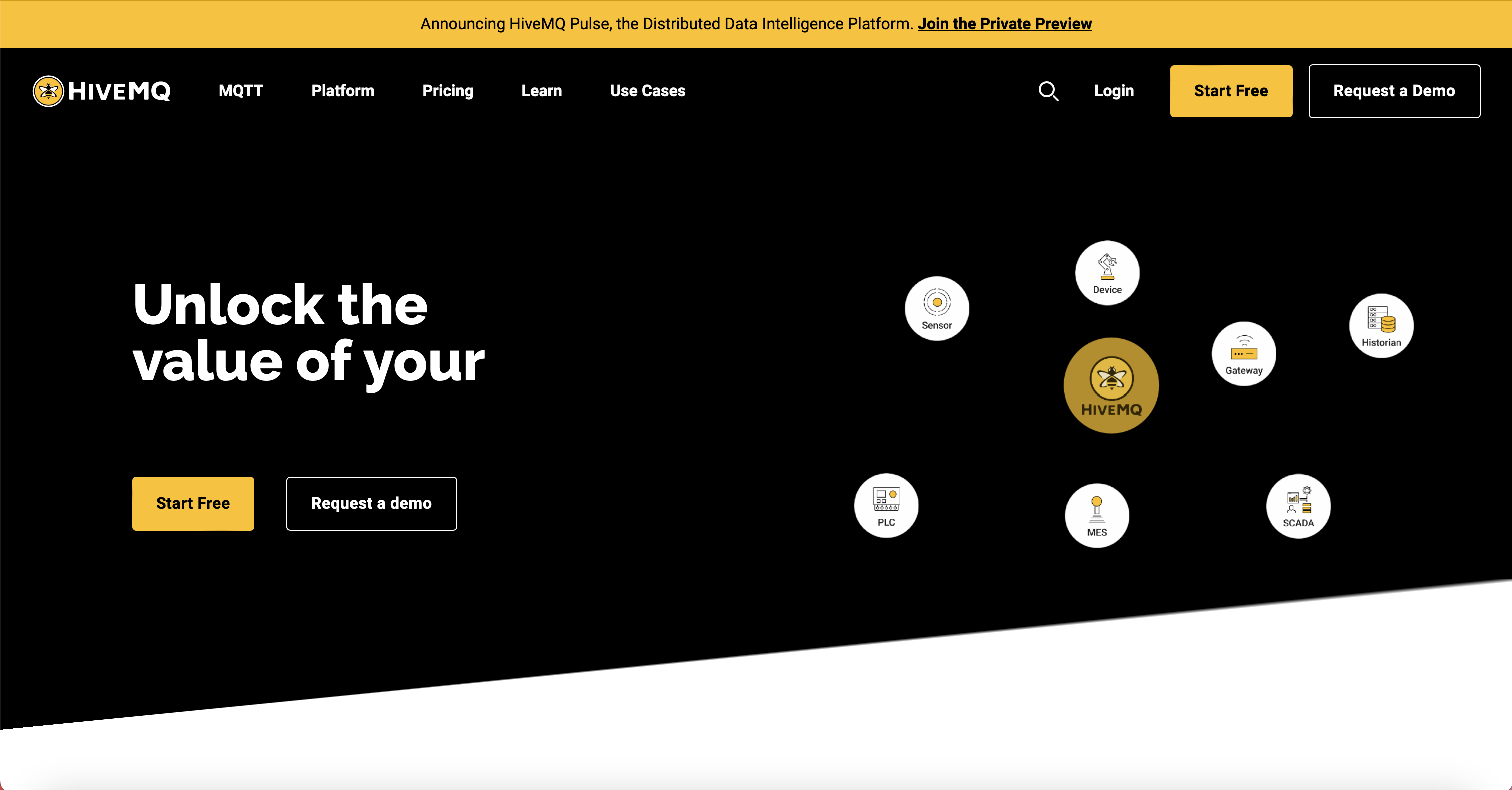
Click on the Sign Up FREE Now button in the HIVEMQ CLOUD section.
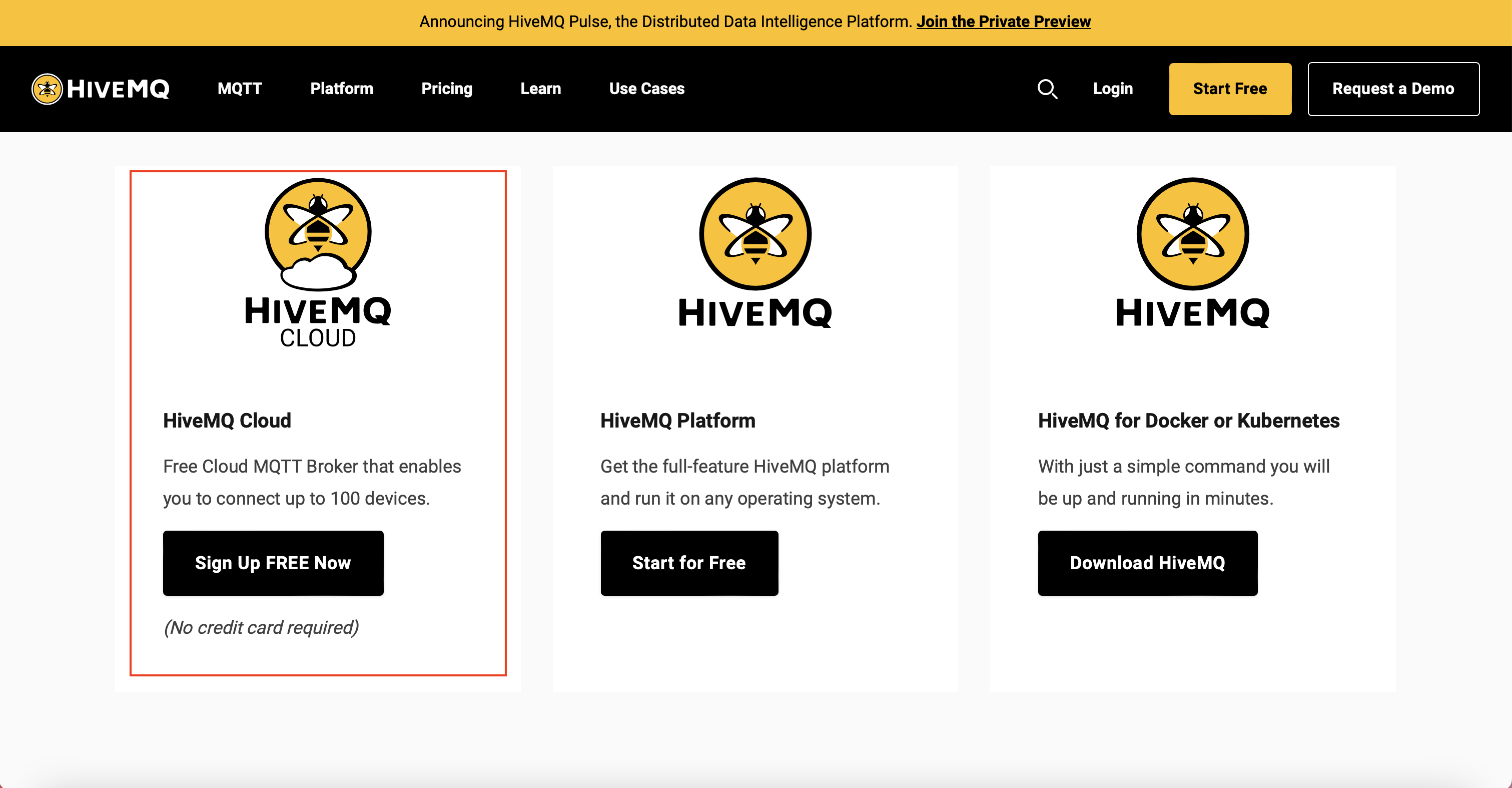
Click on the Sign Up button.
You can sign up with HiveMQ using your GitHub, Google, or LinkedIn account.
If not, provide your email address and a password to create an account by clicking on the Sign Up button.
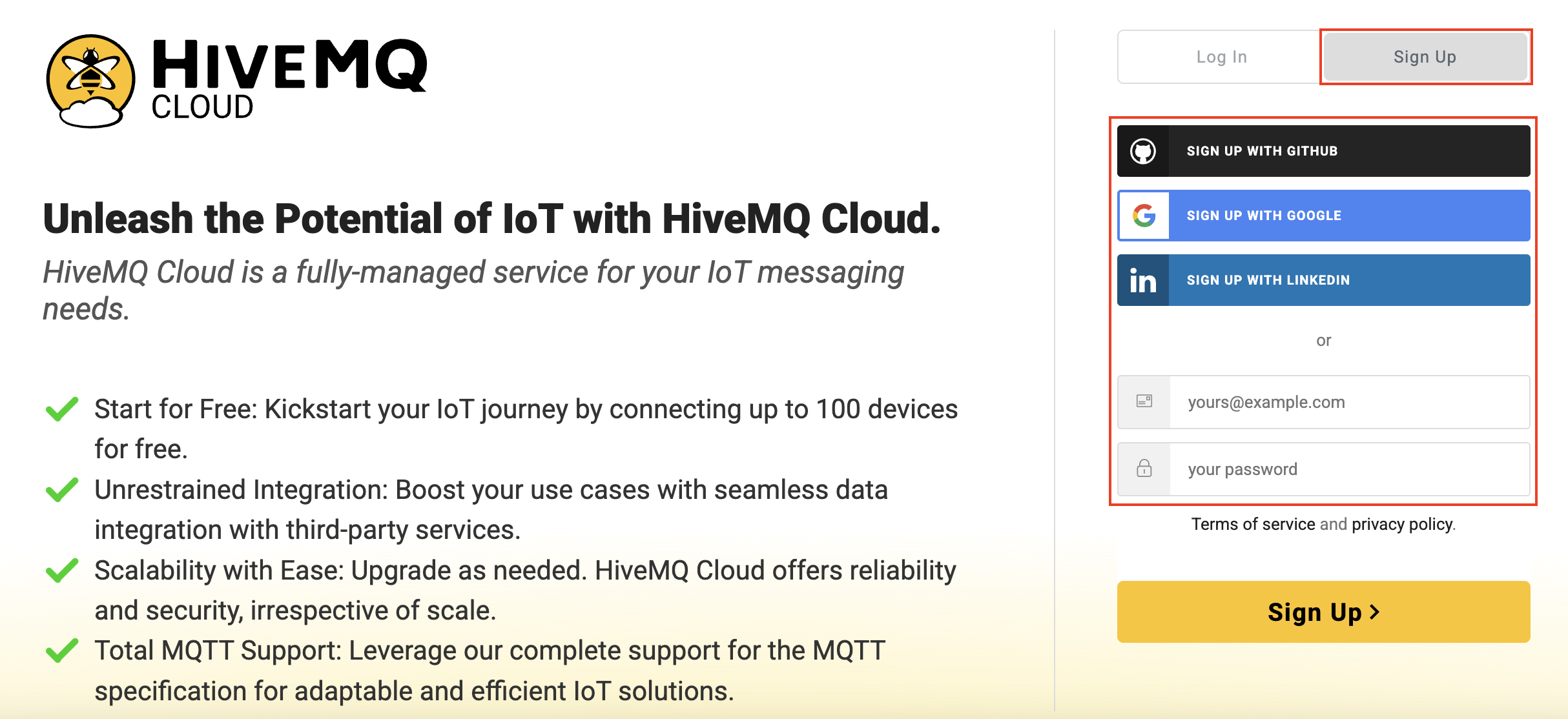
You will receive an email to verify your email address. Click on the Confirm my account button.

You will be redirected to a page asking you to complete your profile. Once done, click the Continue button.

Select the CloudMQ Cloud plan you need. For testing purposes, select the Serverless FREE plan by clicking on the Create Serverless Cluster button.
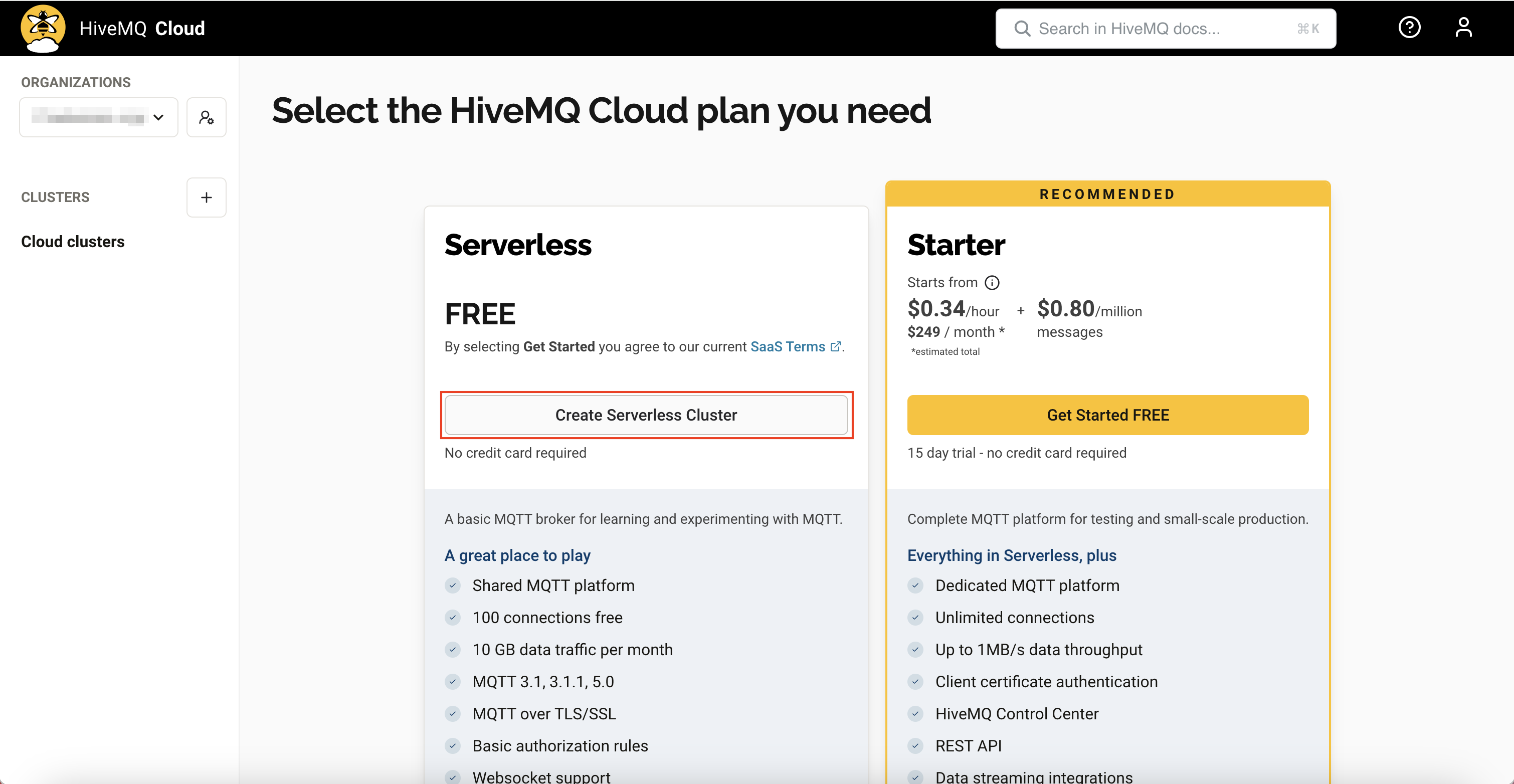
You will be navigated to the Your Clusters page. Click on the Manage Cluster button.
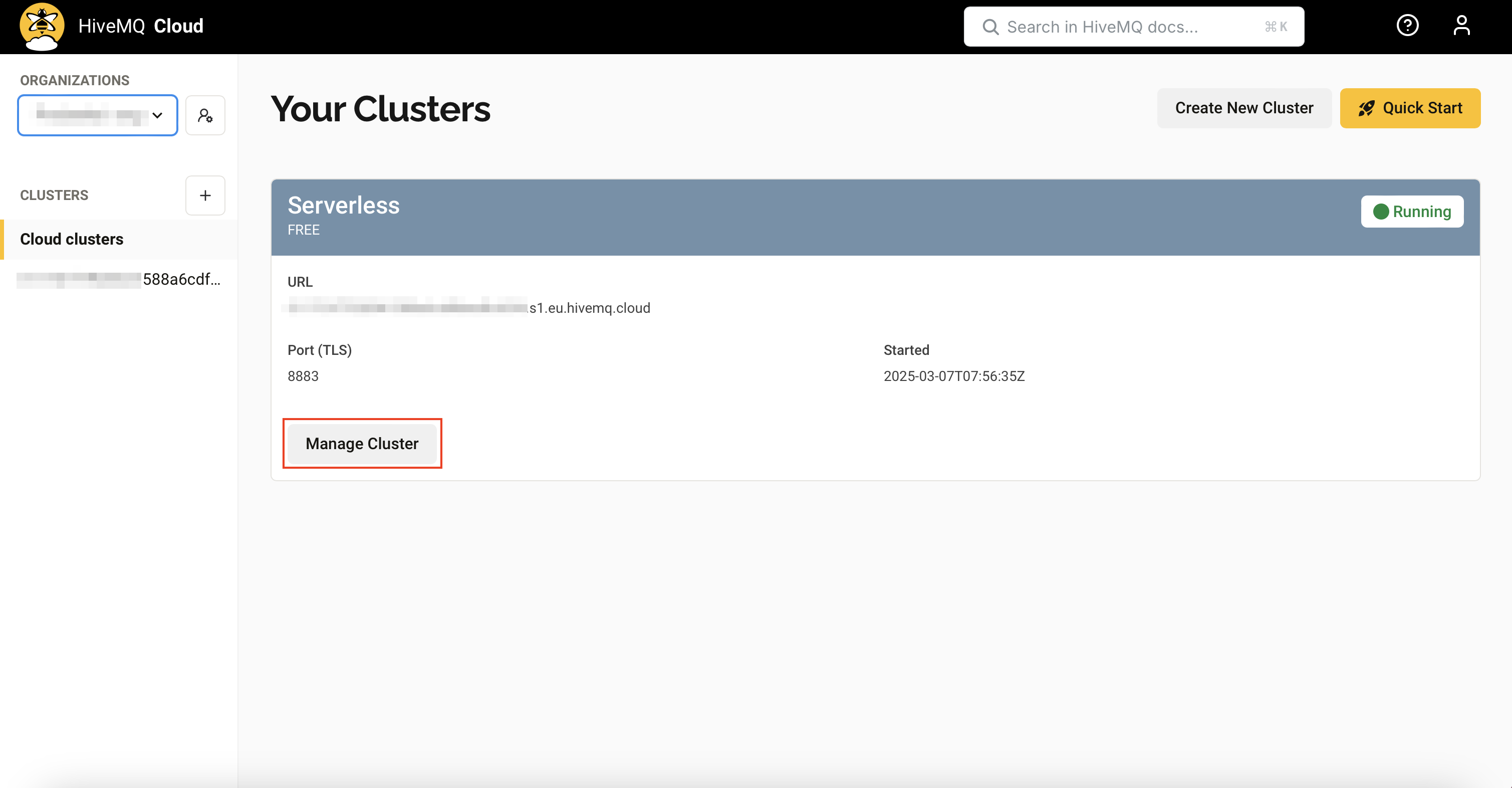
In your cluster page, you can find some useful parameters you need to create a MQTT connection.
URL: This is the host name. Click on the copy button to copy it.
Port: 8883
Click on the Getting Started tab to setup the username and the password as the connection credentials.
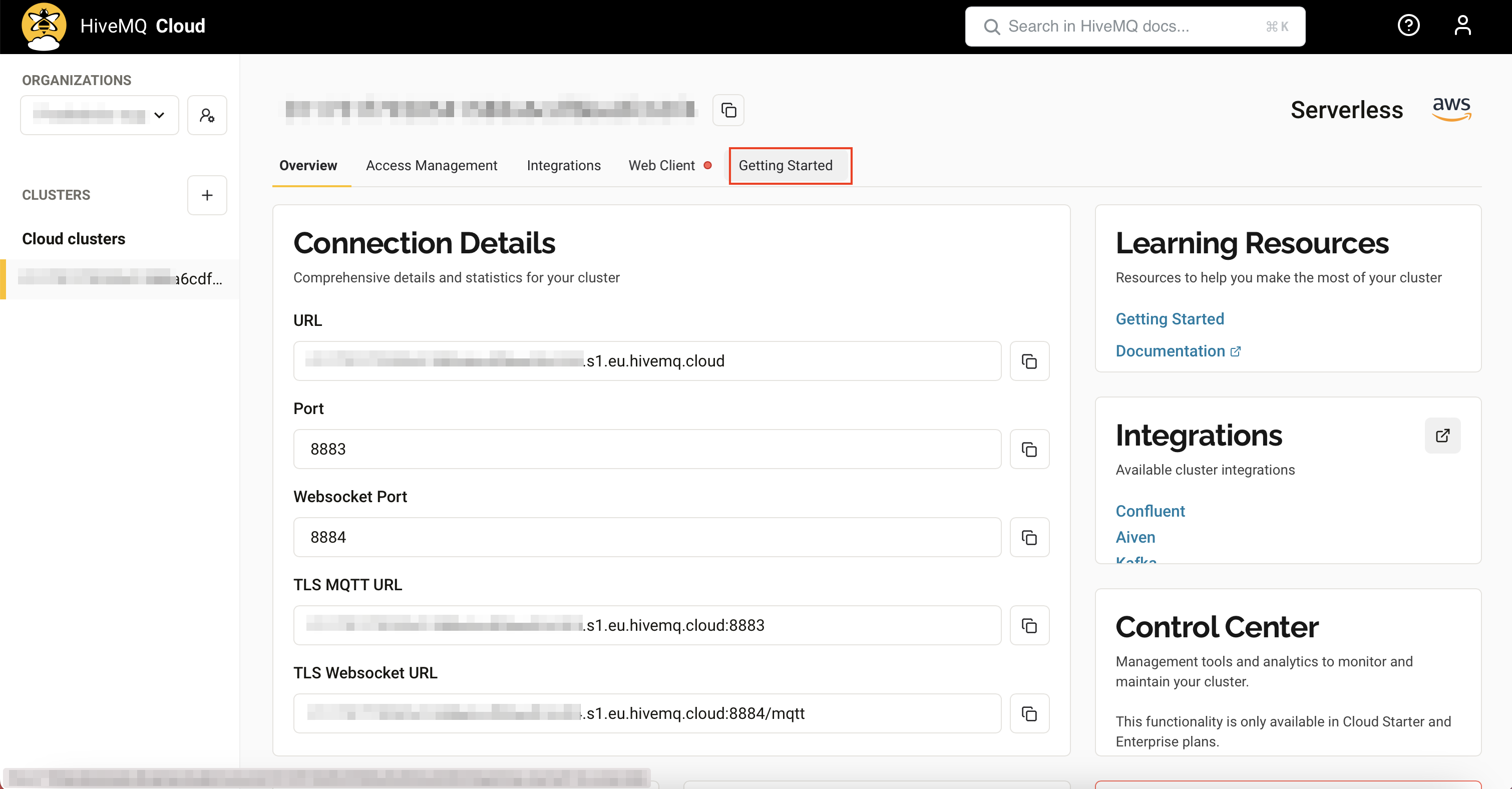
In the 'Create Connection Credentials' section, provide a username and password, then click the Add button.
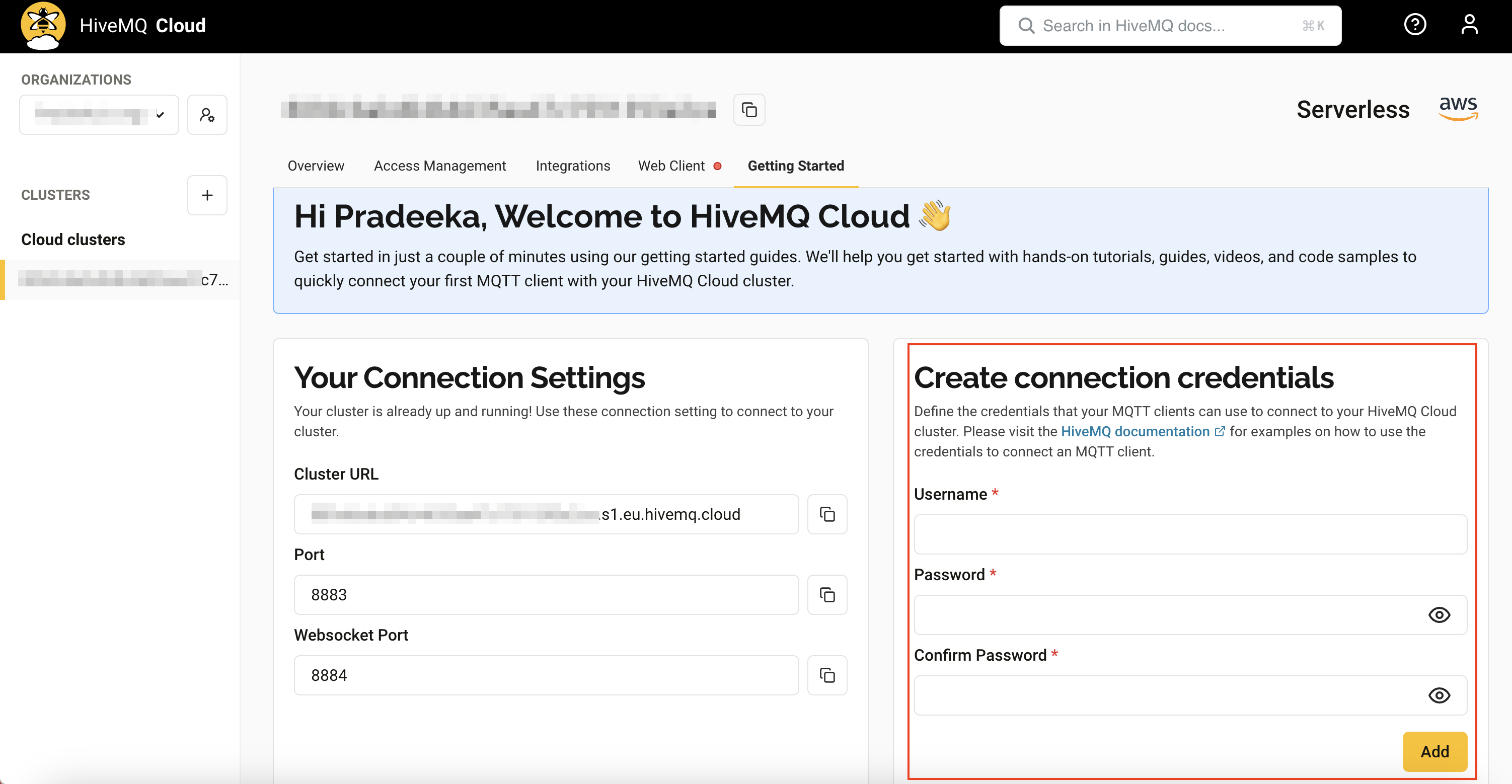
If everything is successful, you will see the following message.

You will need these MQTT connection parameters when configuring the MQTT integration in the 'Add Integration' section.
2.2.2 emqx
The emqx public MQTT server is only used for MOTT learning and testing, and should not be used in the production environment.

2.2.3 Ins1.thingseye.io
lns1.thingseye.io is the Dragino's MQTT broker, which requires a CA certificate file, Certificate file, and the Private key file to use.
If customers need to use this MQTT connection with ThingsBoard, they need to contact the TE team to obtain three license files.

3. Data Converters
In ThingsBoard, Data Converters are components used to transform incoming or outgoing data between different formats, typically to convert raw telemetry data from devices into a structured format that ThingsBoard can understand, or vice versa.
3.1 Uplink
In the left navigation, click Integrations center, and then click Data converters.
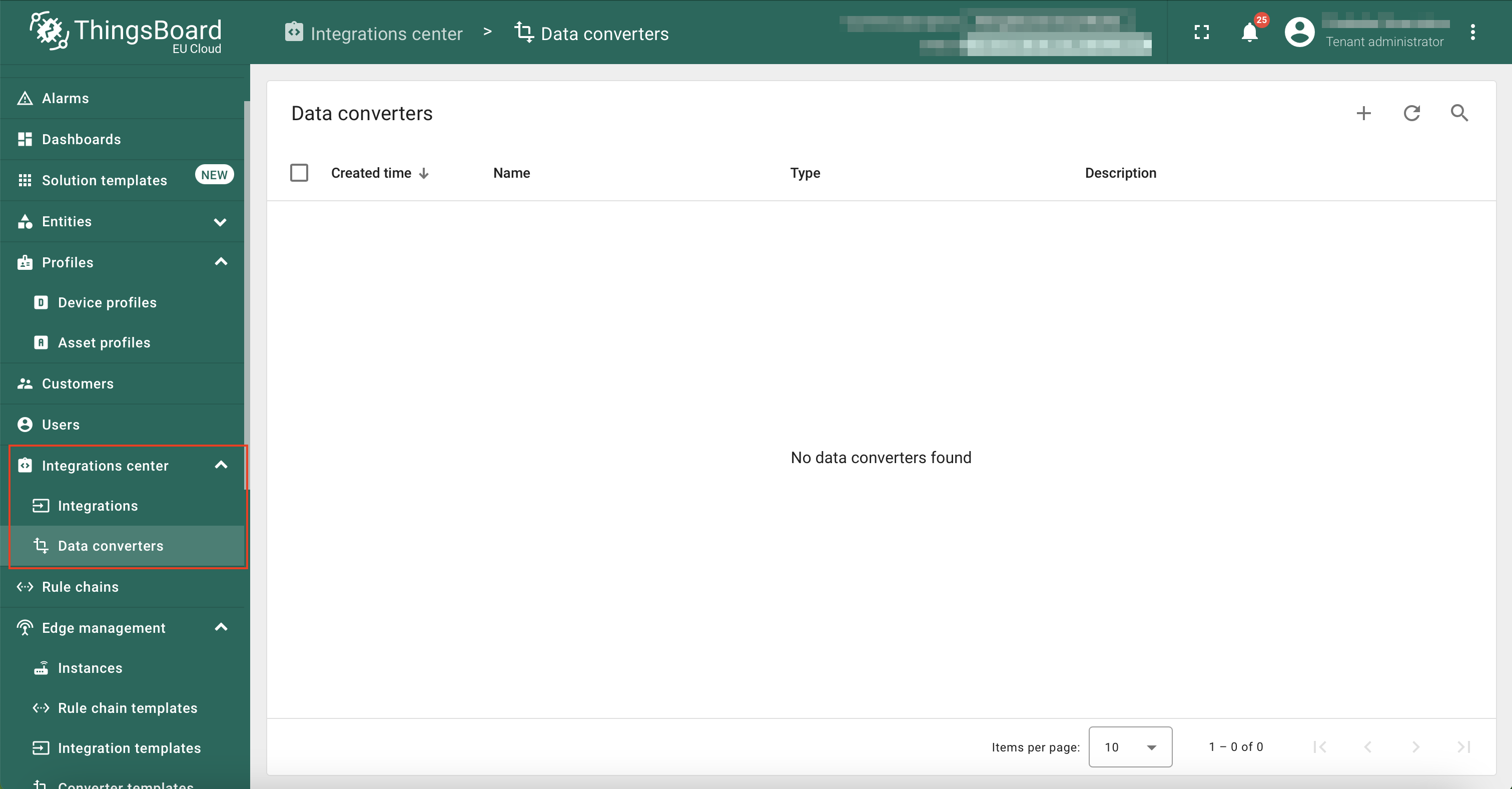
On the Data converters page, click on the ‘+’ button, and then click on the Create new converter from the dropdown menu.

The Add data converter window will appear. Name it ‘MQTT Uplink Converter NB/CB’ and select the Type as Uplink.
Click on the JavaScript button.
Delete the default decoder function in the code editor. Now copy and paste the following decoder function written in JavaScript in to the code editor. This decoder function is compatible for both NB and CB series devices.
// decode payload to string
var payloadStr = decodeToString(payload);
// decode payload to JSON
var objdata = {};
var obj1 = {};
var data = decodeToJson(payload);
var deviceName = data.IMEI;
delete data.IMEI;
var modelname = "Dragino " + data.Model;
//var mod = data.mod
delete data.Model;
//delete data.mod
var timestamp = new Date().getTime();
for (var key in data) {
if (Number(key)) {
obj1[key] = data[key];
obj1[key][obj1[key].length - 1] = Number(new Date(
obj1[key][obj1[key].length - 1]));
}
//Alec submitted25/02/25
//turn old key into new
else if (key === "Reading") {
objdata["reading"] = data[key];
} else if (key === "work mode") {
objdata["work_mode"] = data[key];
} else if (key === "hum") {
objdata["humidity"] = data[key];
}else if (key === "hum2") {
objdata["humidity2"] = data[key];
} else if (key === "hum3") {
objdata["humidity3"] = data[key];
} else if (key === "tem") {
objdata["temperature"] = data[key];
} else if (key === "tem2") {
objdata["temperature2"] = data[key];
} else if (key === "tem3") {
objdata["temperature3"] = data[key];
} else if (key === "DS18B20_Temp") {
objdata["temperature_pro"] = data[key];
} else if (key === "ds18b20_temperature") {
objdata["temperature_pro"] = data[key];
} else if (key === "DS18B20_temperature_pro") {
objdata["temperature_pro"] = data[key];
} else if (key === "tdc send flag") {
objdata["tdc_send_flag"] = data[key];
} else if (key === "trigger mode") {
objdata["trigger_mode"] = data[key];
} else if (key === "soil dielectric constant") {
objdata["soil_dielectric_constant"] = data[key];
} else if (key === "door open num") {
objdata["door_open_num"] = data[key];
} else if (key === "door duration") {
objdata["door_duration"] = data[key];
} else if (key === "count time") {
objdata["count_time"] = data[key];
} else if (key === "last open time2") {
objdata["last_open_time2"] = data[key];
} else if (key === "last open time3") {
objdata["last_open_time3"] = data[key];
}
//Alec submitted25/02/25
else {
objdata[key] = data[key]
}
}
var listdata = [{
"ts": timestamp,
"values": objdata
}]
for (var key1 in obj1) {
if (modelname == "Dragino RS485-NB") {
listdata.push({
"ts": obj1[key1][obj1[key1].length - 1],
"values": {
"Payload": obj1[key1][0],
}
})
} else {
listdata.push({
"ts": obj1[key1][obj1[key1].length - 1],
"values": {
"values": obj1[key1]
},
})
}
}
var result = {
deviceName: deviceName,
deviceType: modelname,
attributes: {
model: modelname,
//customerName: "NB-CB",
//groupName: "NB-CB",
//integrationName: metadata['integrationName']
},
telemetry: listdata
}
function decodeToString(payload) {
return String.fromCharCode.apply(String, payload);
}
function decodeToJson(payload) {
// covert payload to string.
var str = decodeToString(payload);
// parse string to JSON
var data = JSON.parse(str);
return data;
}
return result;
Click on the Add button.
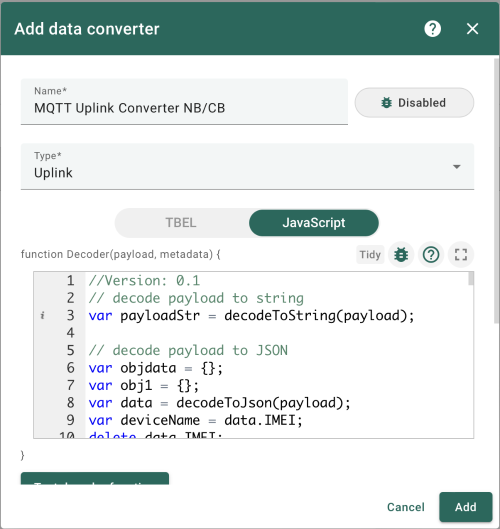
You should see that the newly added MQTT Uplink converter NB/CB is listed on the Data Converters page.
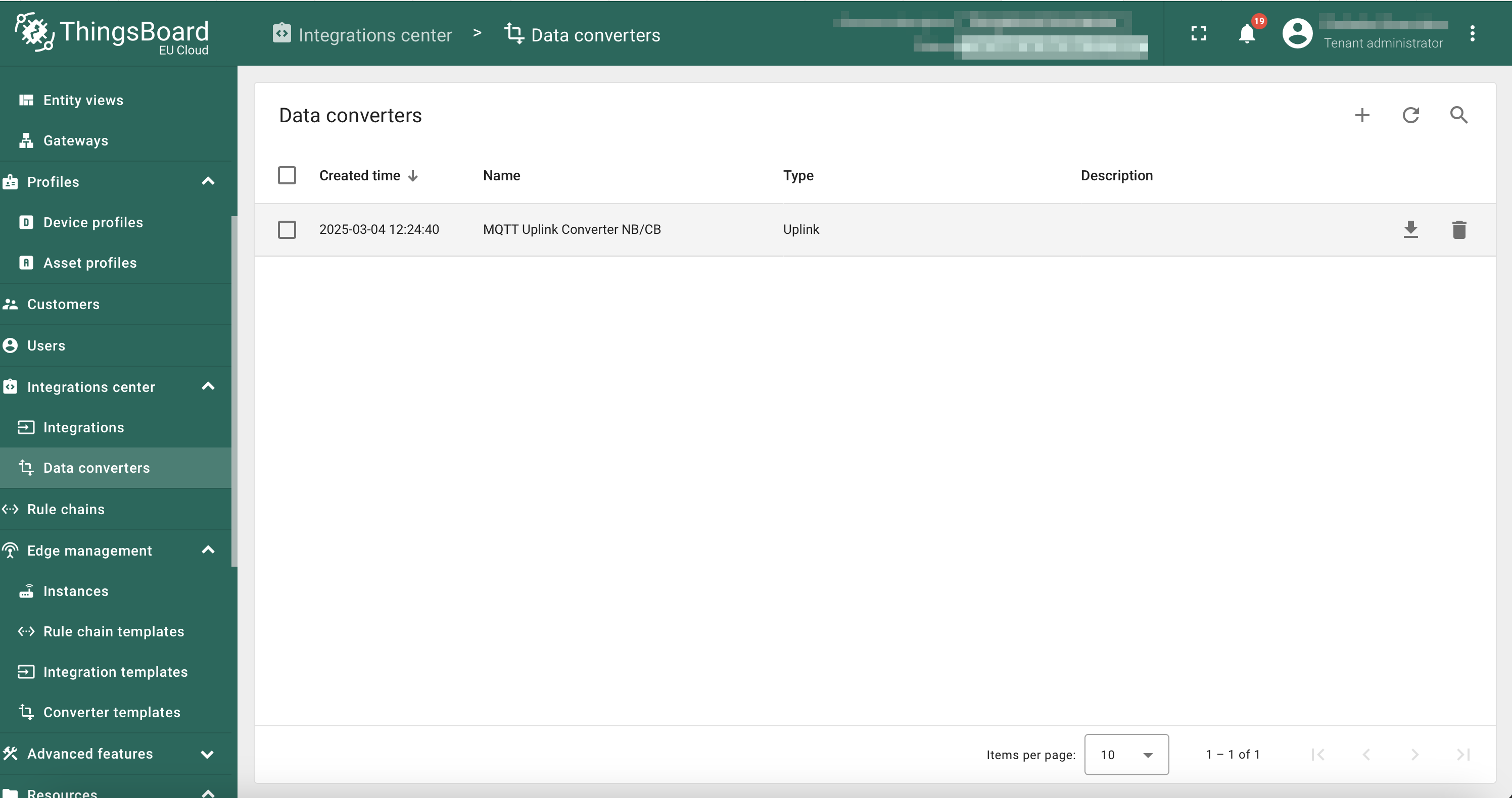
4. Add Integration
In the left navigation, click Integrations center, and then click Integrations.

On the Integrations page, click on the '+' button.
The Add integration window appears.
In the Add integration window, configure the following settings:
Basic settings:
- Integration type: MQTT
- Name: MQTT integration NB/CB
- Enable integration: YES
- Allows create devices or assets: YES
Click Next button.

Uplink data converter:
- Click on the Select existing button.
- Uplink data converter: Select MQTT Uplink Converter NB/CB from the dropdown list.
Click Next button.

Downlink data converter:
Dragino NB/CB devices don't require a downlink data converter to decode their payloads, so you can skip this step.
- Click on the Skip button in the Downlink data converter section.
Click Skip button.

Connection:
- Host: Cluster URL (Eg. 011731f7xxxxxxxxxxxfbbedfc63f4.s1.eu.hivemq.cloud)
- Port: 8883
- Credentials: Basic
- Enable SSL: YES
- Username: Username (from your HiveMQ Cloud Cluster with your credentials)
- Password: Password (from your HiveMQ Cloud Cluster with your credentials)
- Topic: v1/devices/me/telemetry (The topic can be anything, even you can use just the device name, for example ts02-nb)
- QoS: 0-At most once

Click on the Advanced settings button.
- Clean session: YES
- Retained: YES

Click on the Check connection button to verify the MQTT connection using the provided parameters.

If the connection is successful, you will see the Connected message. If not, check your connection parameters again.

Click on the Add button.
You should see that the newly added integration is listed on the Integrations page.
Since we haven't received data from a device yet, the integration Status is shown as Pending.
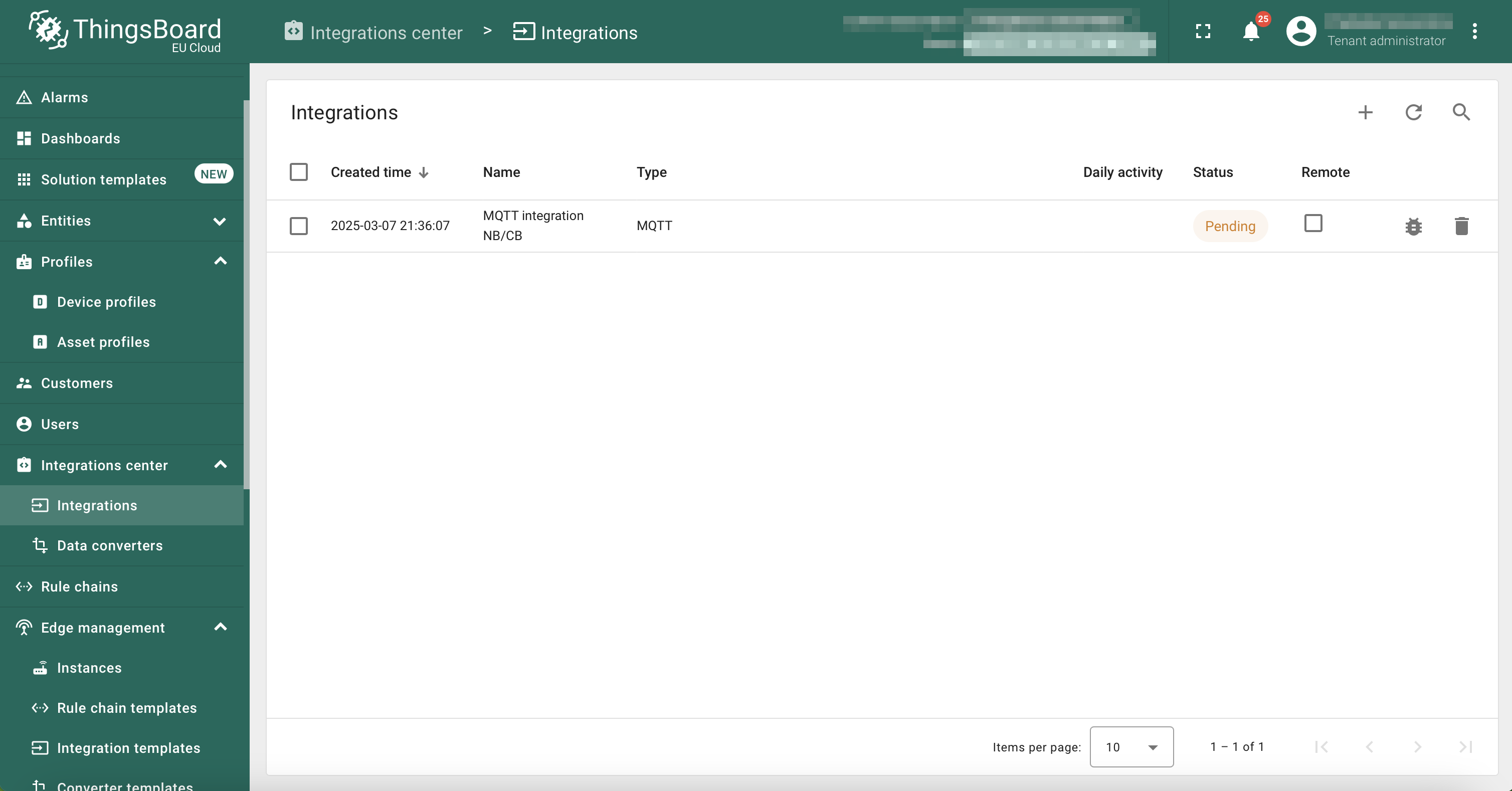
5. Verifying the receipt of data from virtual devices
5.1 How does it work?
We use the Mosquitto MQTT client to simulate MQTT messages, acting as a virtual device. First, install the Mosquitto client on your computer from this link. The Mosquitto client publishes messages to the MQTT broker (HiveMQ) on a specified MQTT topic. ThingsBoard subscribes to these messages using the same topic.
The Mosquitto client publishes messages (payloads) on the topic v1/devices/me/telemetry. Of course, you can use any topic for testing.
The MQTT payload format is as follows, which is common for all --NB and --CB series devices. The IMEI field is mandatory and is used to provision a new device with the name assigned to it in ThingsBoard.
Once ThingsBoard receives this message, it automatically creates (provisions) the device mentioned in the IMEI, for example, S31B-NB.
5.2 Sending messages
On the terminal, issue the following MQTT command which simulates the device S31B-NB. The message payload contains the fields temperature and humidity, which hold the values S31B-NB and 27, respectively. This payload is also (technically) known as telemetry.
If the integration was performed without errors, the status of the integration changes to 'Active' after the first telemetry transmission.

Also, a new device named S31B-NB will appear under Entities -> Devices -> All. This means the first MQTT message triggers ThingsBoard to provision a device named S31B-NB.

5.3 Viewing messages
Go back to the Integrations page.
Click on the MQTT integration NB/CB in the Integrations page to see its details.
Click on the Edit button (pen icon).
Click on the Disabled button in the upper-right corner.
Turn on the All messages (15 min) option. This will enable displaying all messages in the Events tab. This setting will expire in 15 minutes, and you will need to repeat the same steps if you want to view the messages in the Events tab later.
Click on the Apply button.
Then click on the Apply changes (tick icon) button.
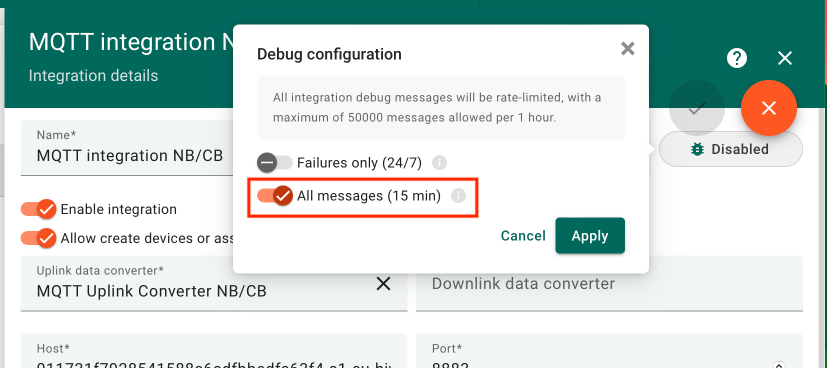
Now go to the Events tab.
Select the Event type as Debug from the dropdown list.
Now you can see all the Uplink messages you are simulating through the MQTT broker. The status should be OK if there is no errors in your integration.
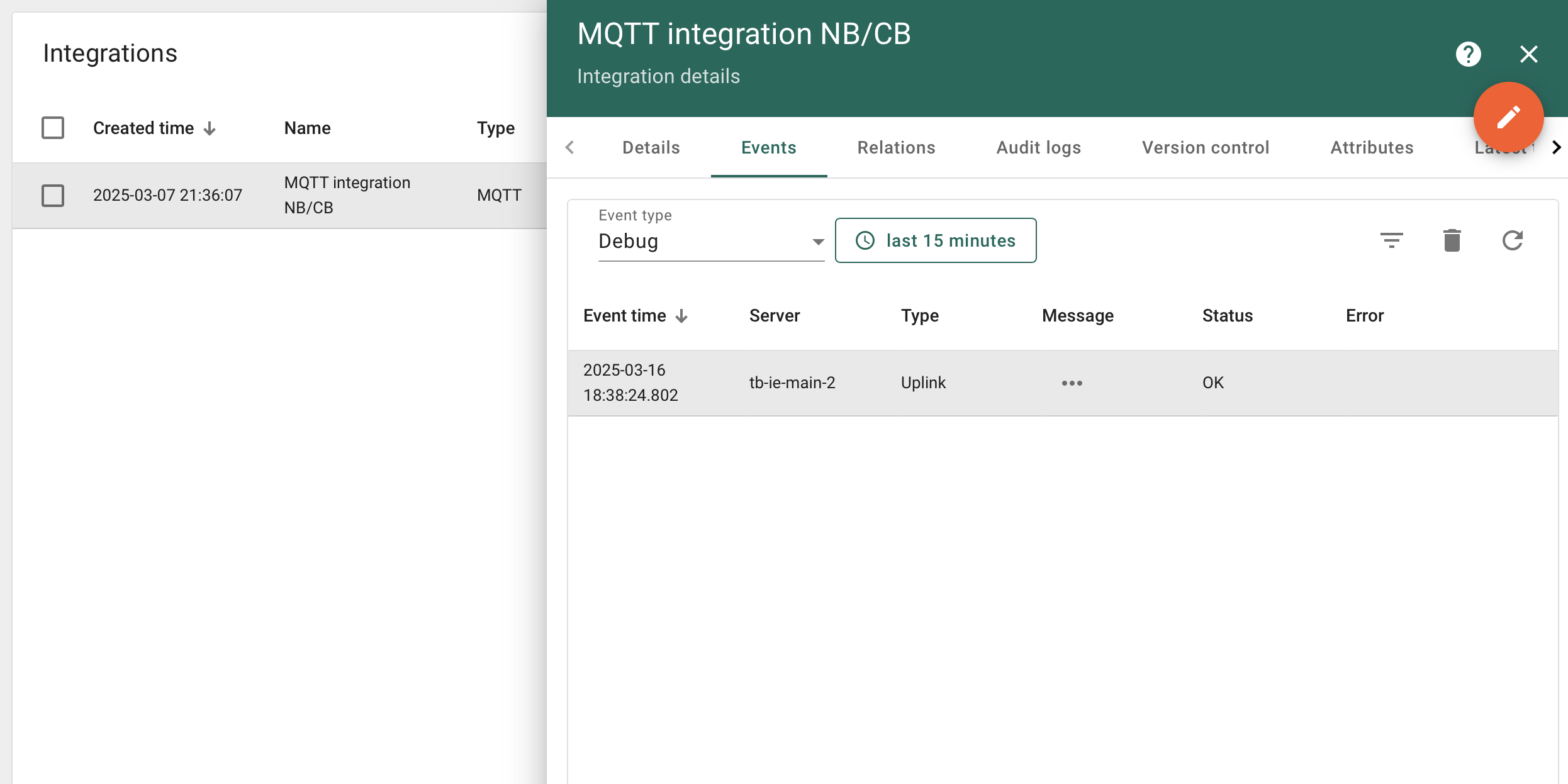
Then click on the three dots (...) in the Message column. You can see the uplink message's payload in the Message window.
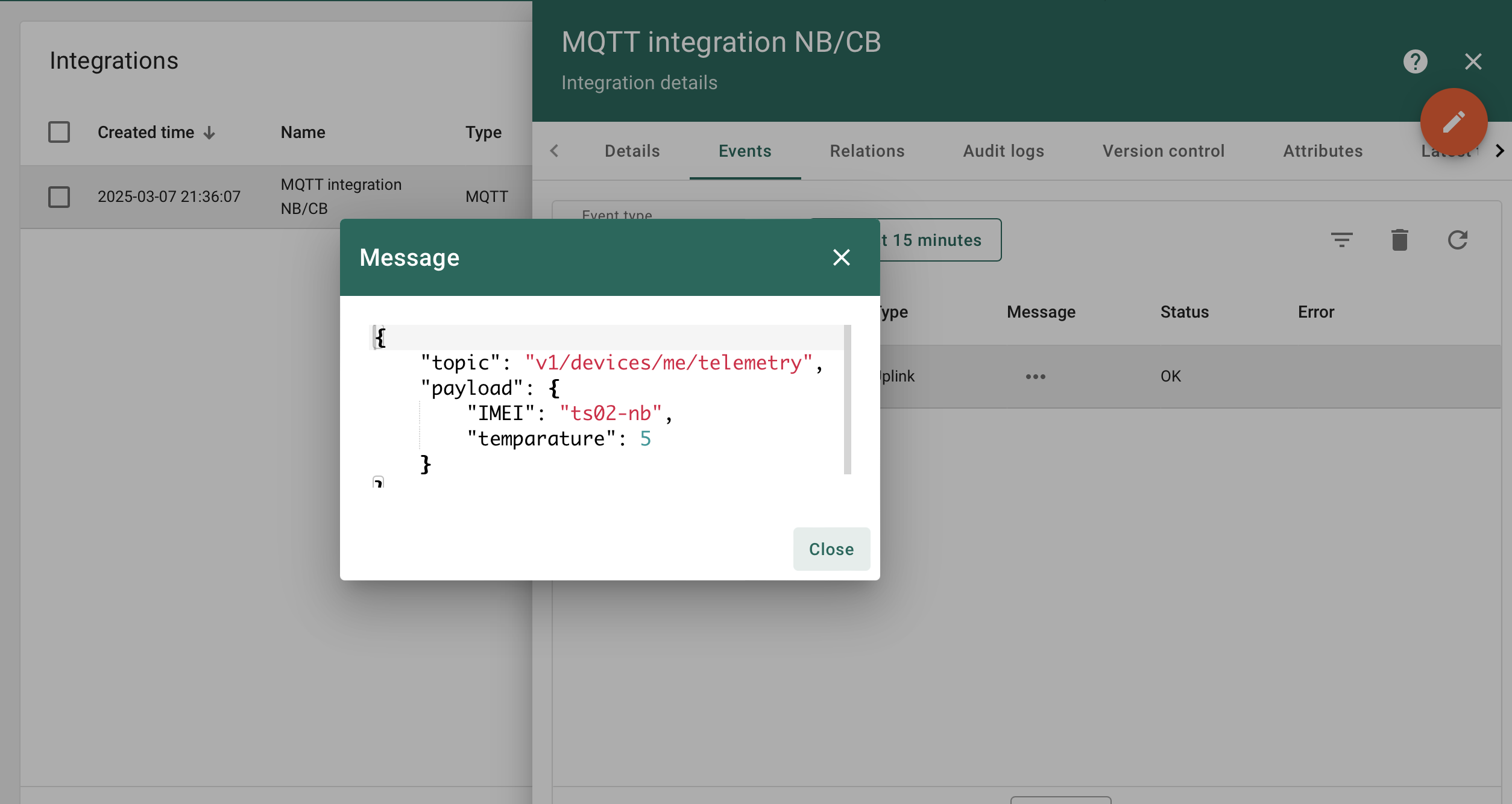
Now, you have successfully tested your integration with a simulated uplink payload and verified that it is received by ThingsBoard, and the device is provisioned.
6. Creating a Dashboard
ThingsBoard Dashboards provide a powerful way to visualize and monitor real-time and historical data from connected devices. They allow users to create interactive, customizable panels displaying telemetry data, device status, and other key metrics. With a variety of widgets, including charts, maps, and tables, dashboards help users gain insights, track trends, and manage IoT deployments efficiently.
This section guides you on how to create a dashboard to display temperature and humidity data from the device on a time-series chart. You may also use other widgets in ThingsBoard to display data according to your requirements.
First simulate a few messages using MQTT. This time, we have added the 'humidity' field to the payload. Eg:
mosquitto_pub -d -q 1 -h 011731f7928xxxxx.s1.eu.hivemq.cloud -p 8883 -t "v1/devices/me/telemetry" -u "xxxxx" -P "xxxxx" -m '{"IMEI": "S31B-NB", "temperature": 22, "humidity":80}'
In ThingsBoard, from the left navigation menu, click Dashboards. Then, click the + button and select Create new dashboard from the dropdown menu.
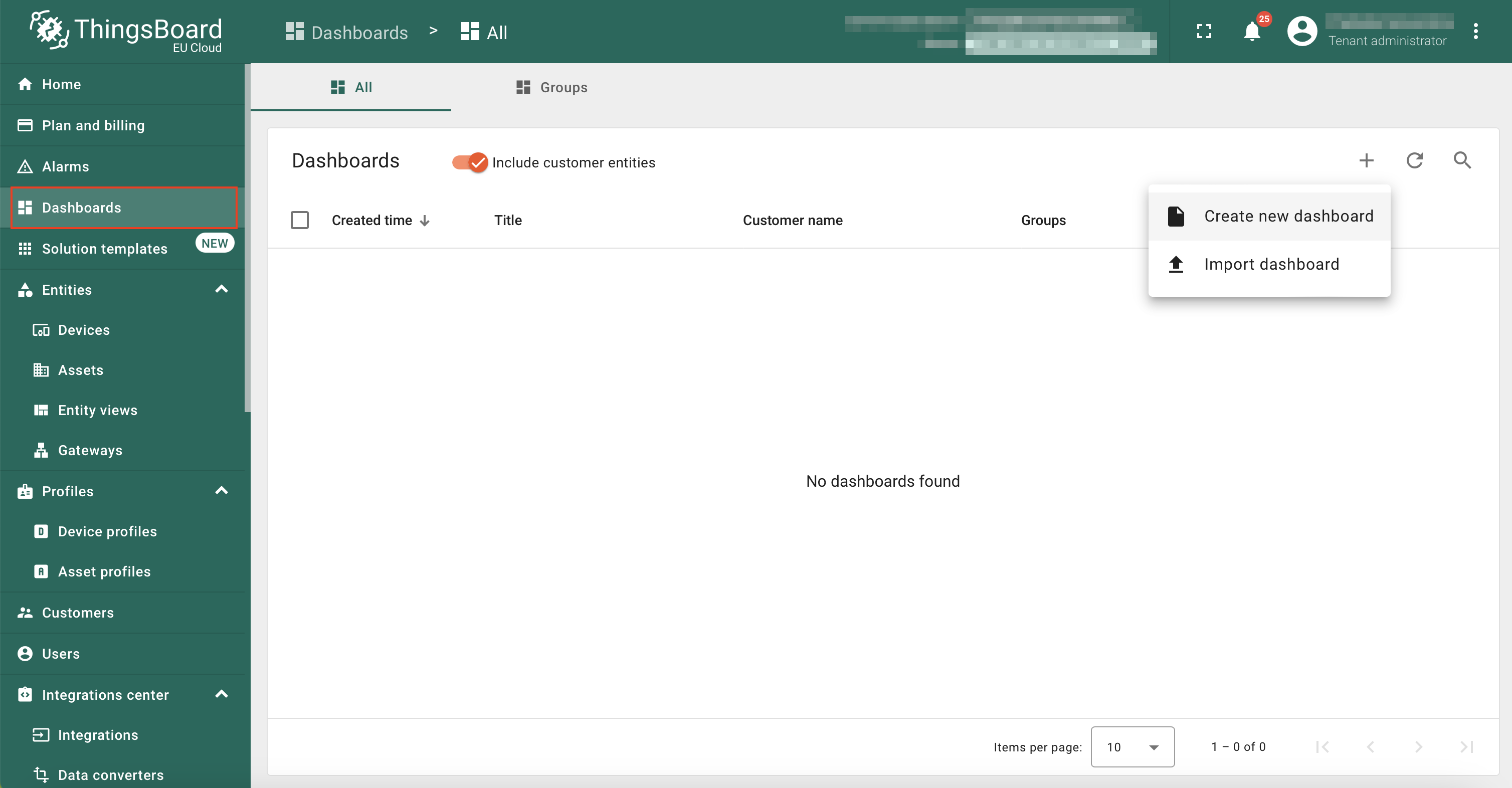
In the Title text box, enter NB/CB Test Dashboard as the title of the dashboard.
Click on the Add button.

Click on the Add widget / Add new widget button.
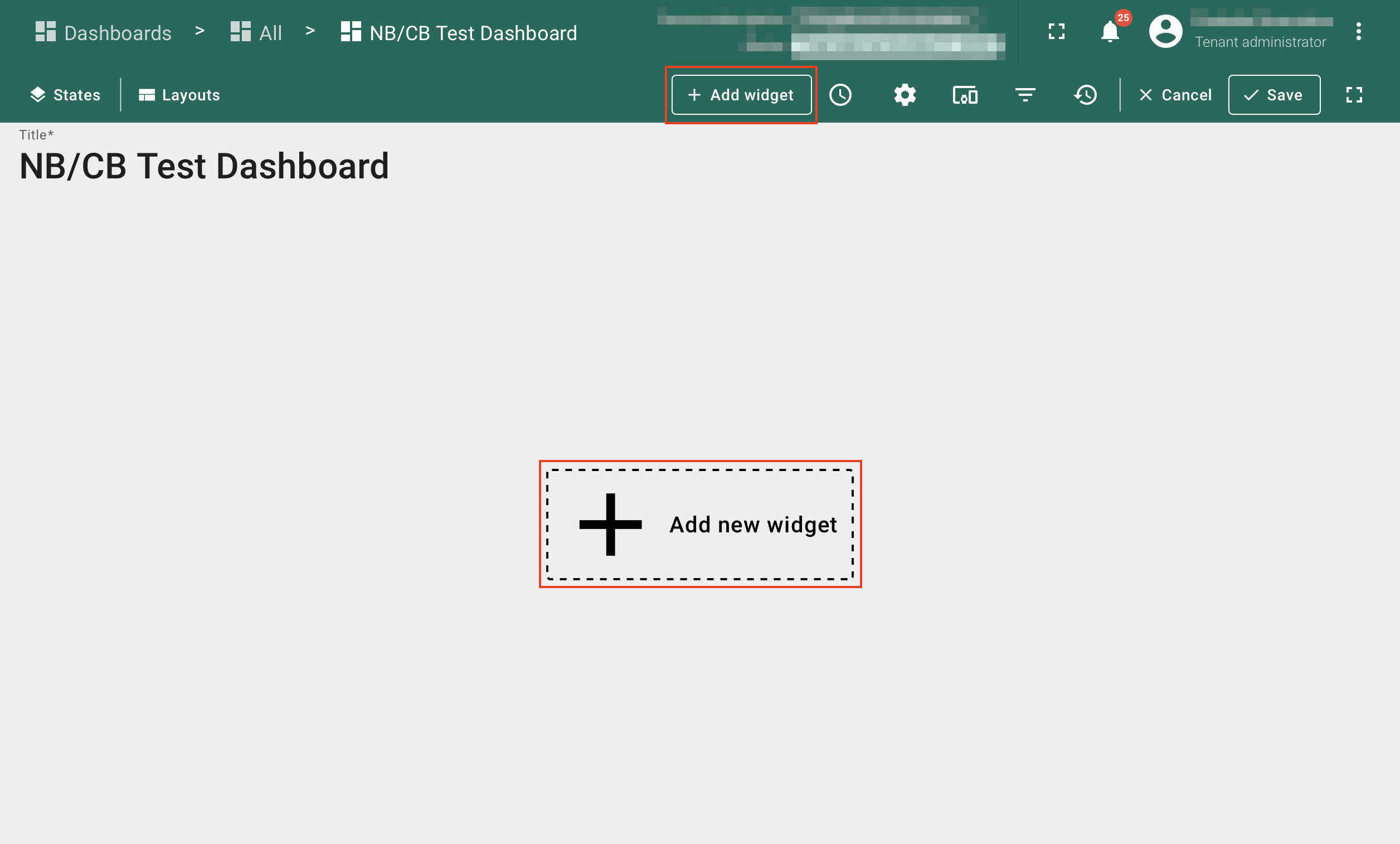
In the Select widgets bundle window, click Charts.

In the Charts: select widget window, click Time series chart.

Configure the Time series chart widget as follows:
- Datasource - select S31B-NB device you provisioned.
- Series:
- temperature - you can see this key by default.
- humidity - Click Add series button. Then add the humidity for the key and then type % as its unit.
- Click on the Add button.

The time-series chart will appear in edit mode. Resize it by clicking and dragging the lower-right corner.
Click the Save button to add the widget to the dashboard.

Now send the following MQTT messages from the terminal to simulate the data.
mosquitto_pub -d -q 1 -h 011731f7928xxxxx.s1.eu.hivemq.cloud -p 8883 -t "v1/devices/me/telemetry" -u "xxxxx" -P "xxxxx" -m '{"IMEI": "S31B-NB", "temperature": 27, "humidity":72}'
mosquitto_pub -d -q 1 -h 011731f7928xxxxx.s1.eu.hivemq.cloud -p 8883 -t "v1/devices/me/telemetry" -u "xxxxx" -P "xxxxx" -m '{"IMEI": "S31B-NB", "temperature": 19, "humidity":80}'
The chart will update with the values in realtime, as shown in the below image.

7. Configure NB-IoT Sensor
Now, let's experiment with sending data to ThingsBoard using a real NB-IoT device. For example, we will use the TS01-NB.
First, configure the NB-IoT device with the necessary MQTT settings using AT commands. Below is a list of AT commands you can use.
AT Commands
- AT+PRO=3,3 // Use MQTT to connect to ThingsBoard. Payload Type set to 3.
- AT+SUBTOPIC=<MQTT subscribe topic>
- AT+PUBTOPIC=<MQTT publish topic> Eg: TS01-NB
- AT+CLIENT=null
- AT+UNAME=<MQTT Username>
- AT+PWD=<MQTT Password>
- AT+SERVADDR=<Broker address, Port>
Test your uplink by pressing the ACT button for 1 second.
The following image shows the uplink payload of a real Dragino device. The publish topic is TS01-NB, and the device name is 861275077962896, which is represented by the IMEI.
